|
|
|
Sort Order |
|
|
|
Items / Page
|
|
|
|
|
|
|
| Srl | Item |
| 1 |
ID:
137796
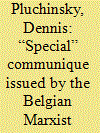

|
|
|
|
|
| Summary/Abstract |
This section of Studies in Conflict & Terrorism is dedicated to the reprinting of selected, translated terrorist communiqués that provide insights into the mindset, worldview, or operational thinking of a group. In terms of communiqués, this section employs the following typology of terrorist communiqués. There are three types of terrorist communiqués: attack, strategic, and special. Attack communiqués are issued to claim responsibility for an attack, explain the target selected, and provide the political rationale for attacking the target. A strategic communiqué is a longer document that is issued to provide strategic direction or commentary on political events, issues, and developments relevant to the group's cause and constituency. It can be used to explain changes of strategy or reinforce the strategic direction of the group. The special communiqué is similar to the attack communiqué in that it is event-driven but addresses non-attack events like anniversary dates, hunger strikes, elections, deaths of leaders, ceasefires, issuing threats or warnings, annual progress reports, issuing apologies, and so on. All three communiqués are issued publicly and intended to influence various audiences.
|
|
|
|
|
|
|
|
|
|
|
|
|
|
|
|
| 2 |
ID:
066239
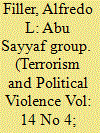

|
|
|
| 3 |
ID:
097164
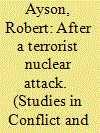

|
|
|
|
|
| Publication |
2010.
|
| Summary/Abstract |
It is just possible that a terrorist nuclear attack could catalyze an inter-state nuclear war. The likelihood of a terrorist group gaining access to nuclear weapons is lower than some fear, and terrorists might not use a nuclear weapon as soon as they had acquired one. But if a terrorist group was to explode a nuclear device in a country that was itself armed with nuclear weapons, and especially if that country was in a conflict-prone relationship with another nuclear-armed state, the broader consequences of even a single terrorist nuclear detonation could be much more serious than some assume.
|
|
|
|
|
|
|
|
|
|
|
|
|
|
|
|
| 4 |
ID:
151373
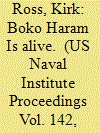

|
|
|
|
|
| Summary/Abstract |
he Terrorist group in Nigeria has been pronounced dead. It is far from it.
|
|
|
|
|
|
|
|
|
|
|
|
|
|
|
|
| 5 |
ID:
097172
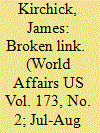

|
|
|
| 6 |
ID:
077787
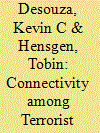

|
|
|
|
|
| Publication |
2007.
|
| Summary/Abstract |
The reality of terrorism has become ubiquitous. Terrorist groups continue to garner front-page exposure, which contributes to their agenda, while stories of hostage dilemmas, suicide bombings, assassinations, and a variety of nefarious criminal activities lead the unsuspecting to wonder, "What's next?" In order to begin to understand terrorism researchers should first understand how these terrorist groups operate and, far more importantly, what motivates others to co-operate with terrorists. No terrorist group operates in isolation. It is assured a priori that terrorist groups have to collaborate with other entities in order to further their agenda. In the conventional sense, terrorists have limited resources, limited capabilities, and limited reach. Without co-operation and support in support of criminal enterprises, they would function in isolation; their impact would be isolated. This article outlines two models that demonstrate how cooperation between terrorists and recognized, albeit criminal, institutions contribute to terrorist successes. The first, a resource model, outlines some of the resources that bind two or more terrorist groups. The second, an alliance model, layers different levels of collaborative engagements between terrorist groups and these institutions. Both models are descriptive in nature and contribute to an understanding of how terrorist groups must engage in the fundamentals of established economic practices in order to succeed.
|
|
|
|
|
|
|
|
|
|
|
|
|
|
|
|
| 7 |
ID:
091438
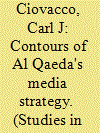

|
|
|
|
|
| Publication |
2009.
|
| Summary/Abstract |
Al Qaeda has crafted a successful media strategy that is adeptly suited for the war of ideas against the United States. Osama bin Laden and Ayman al-Zawahiri have demonstrated a great ability to lead plural groups and exploit innovation with the use of technology. This article explores how they have connected with diverse audiences around the world with a constant message. The repetition of their platform themes and use of "message projection opportunities" demonstrate a great understanding of human nature, marketing strategy, global media, and world politics. In line with Prospect Theory, bin Laden and Zawahiri's messaging strategy emphasizes stemming losses over solidifying gains. Only through a better understanding of Al Qaeda's media strategy and all of its strengths, weaknesses, and idiosyncrasies can the United States truly recognize what it is up against and begin to construct an effective and comprehensive counter strategy.
|
|
|
|
|
|
|
|
|
|
|
|
|
|
|
|
| 8 |
ID:
137831
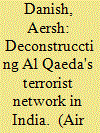

|
|
|
|
|
| Summary/Abstract |
Al Qaeda is characterised by a broad based ideology, a novel structure, a robust capacity for regeneration and a very diverse membership that cuts across ethnic, class and national boundaries. It is neither a single group nor a coalition of groups: it comprises a core base or bases in Afghanistan, satellite terrorist cells worldwide, a conglomerate of Islamist political parties, and other largely independent terrorist groups that it draws on for offensive actions and other responsibilities.
|
|
|
|
|
|
|
|
|
|
|
|
|
|
|
|
| 9 |
ID:
065282


|
|
|
|
|
| Publication |
Sep-Oct 2005.
|
|
|
|
|
|
|
|
|
|
|
|
|
|
|
|
| 10 |
ID:
076663
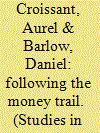

|
|
|
| 11 |
ID:
054175
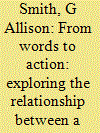

|
|
|
|
|
| Publication |
Sep-Oct 2004.
|
|
|
|
|
|
|
|
|
|
|
|
|
|
|
|
| 12 |
ID:
137960
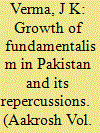

|
|
|
|
|
| Summary/Abstract |
The Islamic republic of Pakistan was created in the name of Islam, but Muhammad Ali Jinnah, the father of the nation, wanted a secular Muslim state and not a theocratic Islamic state controlled by fundamentalists.
|
|
|
|
|
|
|
|
|
|
|
|
|
|
|
|
| 13 |
ID:
154669
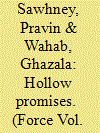

|
|
|
| 14 |
ID:
067798
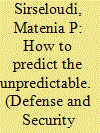

|
|
|
| 15 |
ID:
107029
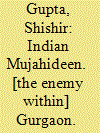

|
|
|
|
|
| Publication |
Gurgaon, Hachette India, 2011.
|
| Description |
xiv, 314p.
|
| Standard Number |
9789350092521, hbk
|
|
|
|
|
|
|
|
|
|
|
|
Copies: C:1/I:0,R:0,Q:0
Circulation
| Accession# | Call# | Current Location | Status | Policy | Location |
| 056185 | 363.3250954/GUP 056185 | Main | Withdrawn | General | |
|
|
|
|
| 16 |
ID:
137581
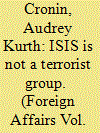

|
|
|
|
|
| Summary/Abstract |
After 9/11, many within the U.S. national security establishment worried that, following decades of preparation for confronting conventional enemies, Washington was unready for the challenge posed by an unconventional adversary such as al Qaeda. So over the next decade, the United States built an elaborate bureaucratic structure to fight the jihadist organization, adapting its military and its intelligence and law enforcement agencies to the tasks of counterterrorism and counterinsurgency.
|
|
|
|
|
|
|
|
|
|
|
|
|
|
|
|
| 17 |
ID:
099824


|
|
|
|
|
| Publication |
2010.
|
| Summary/Abstract |
Jemaah Islamiyah (JI) has shifted its structure and strategies several times since its inception, and its ability to evolve over time has ensured its survival. This article evaluates the evolution of JI's influence in Indonesia and its shift in strategy, in an attempt to address the broader issue of its survival as an organization. It hypothesizes that while internal factors initiated the current strategy shift to an ideological and political focus, external factors have successfully exploited and solidified that shift. Explaining JI's historical evolution in four phases, it concludes by considering possibilities for a "fifth phase" of peaceful political participation.
|
|
|
|
|
|
|
|
|
|
|
|
|
|
|
|
| 18 |
ID:
105547
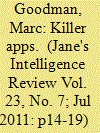

|
|
|
| 19 |
ID:
105985
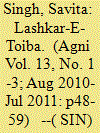

|
|
|
| 20 |
ID:
127879
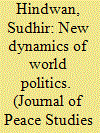

|
|
|
|
|
|
|
|